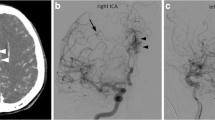Abstract
Background
The occurrence of concomitant multiple cerebral arteriovenous malformations (mAVMs) is often associated with hereditary hemorrhagic telangiectasia (HHT) or craniofacial arteriovenous metameric syndrome (CAMS) and frequently occurs in the pediatric population.
Methods
Between 1995 and 2013, demographic, clinical, and angiographic data of cerebral AVMs have been prospectively collected. We retrospectively analyzed data of patients presenting multiple cerebral AVMs.
Results
Six patients (mean age, 44 years, male-to-female ratio, 5) presented an angiographic diagnosis of cerebral mAVMs. Only one of them was known to have a HHT. Five patients presented two cerebral AVMs and one patient had three. Three AVMs (23.1 %) presented bleeding at admission. Three patients had supratentorial mAVMs only and the three others had supra and infratentorial AVMs. Only one patient suffered from bleeding of more than one of his mAVMs with an interval of 23 years.
Conclusions
For asymptomatic AVMs discovered incidentally without angiographic bleeding risk, we propose a therapeutic abstention. In case of AVM rupture and bleeding, the other “associated” AVMs (discovered through a complete angiographic assessment) should also be treated if they are not located in an eloquent area and if the treatment does not present technical difficulties. AVMs with a history of bleeding or associated to angiographic risks have to be treated more aggressively.


Similar content being viewed by others
References
Ericson K, Soderman M, Karlsson B, Guo WY, Lindquist C (1994) Multiple intracranial arteriovenous malformations: a case report. Neuroradiology 36:157–159
Hasegawa S, Hamada JI, Morioka M, Kai Y, Takaki S, Ushio Y (1999) Multiple cerebral arteriovenous malformations (AVMs) associated with spinal AVM. Acta Neurochir (Wien) 141:315–319
Iizuka Y, Rodesch G, Garcia-Monaco R, Alvarez H, Burrows P, Hui F, Lasjaunias P (1992) Multiple cerebral arteriovenous shunts in children: report of 13 cases. Childs Nerv Syst 8:437–444
Kuo YH, Santoreneos S, Roos D, Brophy BP (2007) Treatment of multiple arteriovenous malformations in pediatric patients with hereditary hemorrhagic telangiectasia and spontaneous hemorrhage. Report of two cases. J Neurosurg 107:489–494
Mansmann U, Meisel J, Brock M, Rodesch G, Alvarez H, Lasjaunias P (2000) Factors associated with intracranial hemorrhage in cases of cerebral arteriovenous malformation. Neurosurgery 46:272–279, discussion 279–281
Mohr JP, Parides MK, Stapf C, Moquete E, Moy CS, Overbey JR, Al-Shahi Salman R, Vicaut E, Young WL, Houdart E, Cordonnier C, Stefani MA, Hartmann A, von Kummer R, Biondi A, Berkefeld J, Klijn CJ, Harkness K, Libman R, Barreau X, Moskowitz AJ, International Ai (2014) Medical management with or without interventional therapy for unruptured brain arteriovenous malformations (ARUBA): a multicentre, non-blinded, randomised trial. Lancet 383:614–621
Rigamonti D, Spetzler RF (1988) The association of venous and cavernous malformations. Report of four cases and discussion of the pathophysiological, diagnostic, and therapeutic implications. Acta Neurochir (Wien) 92:100–105
Robert T, Blanc R, Ciccio G, Gilboa B, Fahed R, Redjem H, Pistocchi S, Bartolini B, Piotin M (2015) Angiographic factors influencing the success of endovascular treatment of arteriovenous malformations involving the corpus callosum. J Neurointerv Surg 7(10):715–720
Romero FJ, Ibarra B, Rovira M (1988) Double intracranial arteriovenous malformation in the same patient. Neuroradiology 30:87
Salcman M, Scholtz H, Numaguchi Y (1992) Multiple intracerebral arteriovenous malformations: report of three cases and review of the literature. Surg Neurol 38:121–128
Spetzler RF, Martin NA (1986) A proposed grading system for arteriovenous malformations. J Neurosurg 65:476–483
Stone JL, Crowell RM, Lisner BM, Naseem M, Oldershaw JB (1983) Bilateral parietal arteriovenous malformations: report of a case. Neurosurgery 13:587–592
Sunwoo L, Sohn CH, Lee JY, Yi KS, Yun TJ, Choi SH, Cho YD, Kim JH, Park SW, Han MH, Paek SH, Kim YH, Kim JW, Chung HT, Kim DG (2015) Evaluation of the degree of arteriovenous shunting in intracranial arteriovenous malformations using pseudo-continuous arterial spin labeling magnetic resonance imaging. Neuroradiology 57(8):775–782
Utsuki S, Kurata A, Miyasaka Y, Takano M, Ootaka H, Fujii K (2002) Multiple arteriovenous malformations with hemorrhage. Acta Neurochir (Wien) 144:97–101
Willinsky RA, Lasjaunias P, Terbrugge K, Burrows P (1990) Multiple cerebral arteriovenous malformations (AVMs). Review of our experience from 203 patients with cerebral vascular lesions. Neuroradiology 32:207–210
Yoshimoto T, Kashiwaba T, Houkin K, Abe H (1996) Spontaneous disappearance of arteriovenous malformation during staged treatment of multiple cerebral arteriovenous malformations—case report. Neurol Med Chir (Tokyo) 36:812–814
Zellem RT, Buchheit WA (1985) Multiple intracranial arteriovenous malformations: case report. Neurosurgery 17:88–93
Author information
Authors and Affiliations
Corresponding author
Ethics declarations
All procedures performed in studies involving human participants were in accordance with the ethical standards of the institutional research committee and with the 1964 Helsinki Declaration and its later amendments or comparable ethical standards.
Funding
No funding was received for this research.
Conflict of interest
All authors certify that they have no affiliations with or involvement in any organization or entity with any financial interest (such as honoraria; educational grants; participation in speakers’ bureaus; membership, employment, consultancies, stock ownership, or other equity interest; and expert testimony or patent-licensing arrangements), or non-financial interest (such as personal or professional relationships, affiliations, knowledge or beliefs) in the subject matter or materials discussed in this manuscript.
Informed consent
Informed consent was obtained from all individual participants included in the study.
Rights and permissions
About this article
Cite this article
Robert, T., Blanc, R., Botta, D. et al. Management of multiple cerebral arteriovenous malformations in a non-pediatric population. Acta Neurochir 158, 1019–1025 (2016). https://doi.org/10.1007/s00701-016-2785-5
Received:
Accepted:
Published:
Issue Date:
DOI: https://doi.org/10.1007/s00701-016-2785-5




